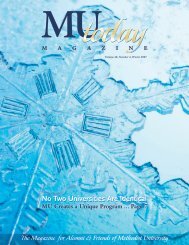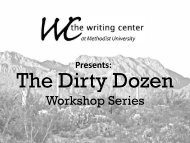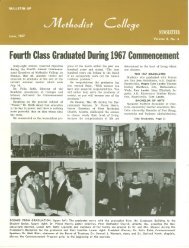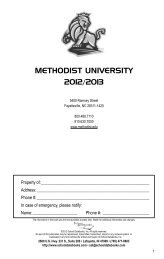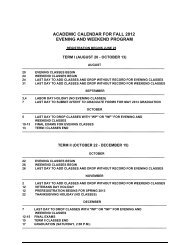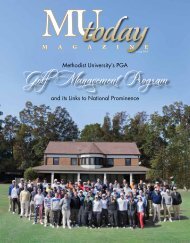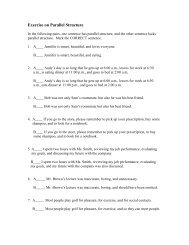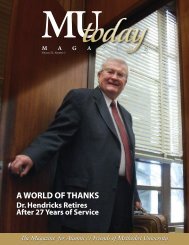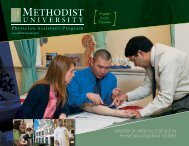Session Abstracts - Methodist University
Session Abstracts - Methodist University
Session Abstracts - Methodist University
You also want an ePaper? Increase the reach of your titles
YUMPU automatically turns print PDFs into web optimized ePapers that Google loves.
of internal and external factors which influenced the city. Examples include the Reformation, the founding of the nation-state of<br />
Germany, the secularization, the “Machtergreifung” by the Nazis, and the looming threat of Soviet invasion through the “Fulda<br />
Gap” during the Cold War. By tracing the development of identity from the early years of recorded civilization to the present day, I<br />
will explain the way the inhabitants of Fulda and the surrounding area are viewed and view themselves, both through ascribed and<br />
asserted identities.<br />
The Party is Always Right: SED, Stasi, and The Failure of “Real Existing Socialism”<br />
Daniel Dessauer; Senior; History & Political Science with a concentration in International Relations; Neuhof, Germany<br />
Advisor: Dr. Peter Murray<br />
“The Sword and Shield of the Party – The Stasi and SED Domination of GDR Society” was originally written as my senior research<br />
thesis. It poses the question of how the dreaded “Stasi,” the political police force of the GDR, managed to prop up the autocratic SED<br />
regime for so long and how it suddenly failed, ultimately enabling the reunification of Germany. In addition to following the blatant<br />
and systemized disregard for human and individual rights in the supposedly “humanistic system” of “real existing socialism,” this<br />
paper also traces the economic strain put on an already fragile economy by what one author has called “the most complete police<br />
state in human history.” The paper ultimately concludes that the Stasi began as a very effective and efficient secret police, but decades<br />
of ever-increasing size and scope of operations, recruitment of the best and brightest away from other necessary function in society,<br />
and missing reforms ultimately led to the downfall of both the Stasi and the police state which it protected.<br />
Rubber, Ideology, Coltan: The Cyclical History of Conflict in Central Africa<br />
Daniel Dessauer; Senior; History & Political Science with a concentration in International Relations; Neuhof, Germany<br />
Advisor: Dr. Carl Dyke<br />
This presentation is based on research done for a class in Contemporary World History in the fall of 2012. With the conflict in<br />
the Democratic Republic of the Congo (DRC) heating up, the cycle of violence in Central Africa is in the news once more. While<br />
Columbium and Tantalum are the current reasons for the fighting, the “casus bellum” has been largely interchangeable. Public<br />
interest in the deadliest conflict since World War II ebbs and flows with the intensity of the fighting, and this paper argues that<br />
the irregular, yet cyclical, spiral of war would continue for another reason, even if Columbium and Tantalum suddenly became<br />
uninteresting. The research for the class consists of a total of three papers. The first deals with conflict minerals, the second with the<br />
Congo conflict, and the last is a comprehensive research paper which ties in actors, factors and wars from pre-colonial times, through<br />
the Belgian occupation, the Cold War, and into current times. Research from all materials submitted will be used to present a large<br />
picture of the dilemma facing the Congo.<br />
Meta-Network Analysis within Cosa Nostra<br />
Michael Duprey; Senior; Global Studies; Hope Mills, NC<br />
Advisor: Dr. Carl Dyke<br />
While traditional social network analysis (SNA) has proven useful in making visual sense of relational data within covert<br />
networks, such analytical methodologies do not provide insight which necessarily reflects the network in its entirety. Applying<br />
strict SNA to the Sicilian organized crime network, Cosa Nostra, shows a hierarchical network with a regimented top-down flow<br />
of information. However, to understand the full topology of a network, it is critical that the entire multiplex meta-network is taken<br />
into consideration. The ongoing project involves: (1) text mining unstructured data obtained from criminal reports and confessions<br />
of “turned” mafiosi to construct an empirical meta-network model of Cosa Nostra; (2) applying the R statistical package and ORA/<br />
DyNet software against the network to examine information flow through the “knowledge network,” and (3) eventually constructing<br />
a predictive multi-agent model. The preliminary results show stark divergence between the knowledge network and the hierarchical<br />
social network, such that information flows in a more democratic, flattened state, connected by only a few actors displaying high<br />
degrees of centrality. By isolating and targeting these linchpin actors, more damage may occur to the entire network than if simply<br />
nominal organizational leaders were target for removal.<br />
8





